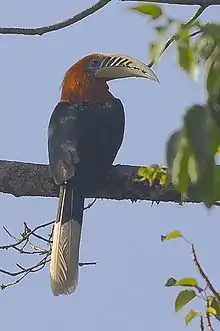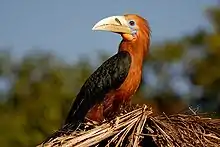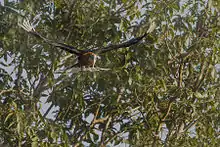Rufous-necked hornbill
The rufous-necked hornbill (Aceros nipalensis) is a species of hornbill in Bhutan, northeastern India, especially in Arunachal Pradesh, Indian Subcontinent and Southeast Asia. It is locally extinct in Nepal due to hunting and significant loss of habitat.[1] There are < 10,000 adults left in the wild.[3] With a length of about 117 centimetres (46 in),[3] it is among the largest Bucerotine hornbills. The underparts, neck and head are rich rufous in the male, but black in the female.
| Rufous-necked hornbill | |
|---|---|
 | |
An adult male (♂) from Mahananda Wildlife Sanctuary in West Bengal, India.
 Rufous necked Hornbill female ♀, Captured in Mahananda WLS, North Bengal, India. Pic by Mayukh Deb. | |
 | |
| An adult female (♀) from Mahananda Wildlife Sanctuary in West Bengal, India. | |
| Scientific classification | |
| Kingdom: | Animalia |
| Phylum: | Chordata |
| Class: | Aves |
| Order: | Bucerotiformes |
| Family: | Bucerotidae |
| Genus: | Aceros Hodgson, 1829 |
| Species: | A. nipalensis |
| Binomial name | |
| Aceros nipalensis | |
Description



The head, neck, and lower body of the male are coloured rufous, with deeper colouration on the flanks and abdomen. The middle primaries and the lower half of the tail are tipped white. The rest of the hornbill's plumage is a glossy dark-green and black. The lower tail-covert feathers are coloured chestnut mixed with black.[4]
The female, on the other hand, is black, except for the end-portion of her tail and the tips of the middle primaries, which are white. Juvenile hornbills resemble adults of the same sex, but lack the ridges at the base of the upper beak.[4]
The beak lacks a true caique but is thickened at its base. It has a number of dark ridges on the upper beak which are absent in the young and increase in number with age up to about seven. The commissure of the beaks is broken for both sexes.[4]
Distribution
Of all hornbills, this species has the northernmost extent, ranging from central Bhutan and north-eastern India to western Thailand and north-western Vietnam.[5]
In India, the hornbill has been recorded from the following protected areas:[6]
- Namdapha National Park, Arunachal Pradesh.
- Manas National Park, Assam.
- Buxa Tiger Reserve, West Bengal.
- Mahananda Wildlife Sanctuary, West Bengal.
- Eaglenest Wildlife Sanctuary, Arunachal Pradesh.
- Kamlang Wildlife Sanctuary, Arunachal Pradesh.
- Sessa Orchid Sanctuary, Arunachal Pradesh.
- Pakke Tiger Reserve, Arunachal Pradesh.[7]
The western limit of the rufous-necked hornbill is the Mahananda Wildlife Sanctuary in West Bengal.[6]
Kinnaird and O'Brien (2007) have tabulated data for the hornbills of the world and report that rufous-necked hornbills range over 1,163,811 km2 (449,350 sq mi) of area, of which 825,837 km2 (318,857 sq mi) of area are forested. Within this area, rufous-necked hornbills occur in 90 protected areas comprising 54,955 km2 (21,218 sq mi) of protected forest but only including 7% of optimal hornbill habitat.[5]:238
Ecology
While predominantly a bird of ridged and hilly forests, chiefly broadleaved forests at altitudes of 150–2,200 metres (490–7,220 ft),[1] it has also been recorded in dry woodland.[3] The nesting period is from March to June, the trees preferred are tall and have broad girths. These hornbill communities move between one forest to another depending on seasonally to forage from fruiting trees that change with local conditions.[3]
Describing the egg, Hume (1889) states:[8]
- The egg is a broad oval, compressed somewhat towards one end, so as to be slightly pyriform. The shell is strong and thick, but coarse and entirely glossless, everywhere pitted with minute pores. In colour it is a very dirty white, with a pale dirty yellowish tinge, and everywhere obscurely stippled, when closely examined, with minute purer white specks, owing to the dirt not having got down into the bottoms of the pores.
It measures 2-25 by 1'75 (inches).
Culture

The rufous-necked hornbill occurs in Sanskrit literature under the epithet vārdhrīnasa, a term which at times also has been used to refer to other Bucerotidae.[9]
In Arunachal Pradesh, rufous-necked hornbills have been hunted by tribals for their feathers and beak.
Conservation
Already listed in CITES Appendices I & II, the species is vulnerable but occurs in a number of protected areas in India, China, Thailand and Bhutan.[3] Due to increased information coming in about range and extent, it has been suggested that the rufous-necked hornbill be downgraded from IUCN status "Vulnerable" to "Near Threatened".[5]:234
Recent initiatives by the Wildlife Trust of India, Arunachal Pradesh Forest Department and other citizens to conserve hornbills, which also target the rufous-necked hornbill, are the Hornbill Nest Adoption Programme, and a programme for replacing the use of real beaks with fibre-made replicas.[7][10] .
References
- BirdLife International (2012). "Aceros nipalensis". IUCN Red List of Threatened Species. 2012. Retrieved 26 November 2013.CS1 maint: ref=harv (link)
- Hodgson, B.H. (1833). "On a new species of Buceros". Asiatic Researches. 18: 178–186.
- BirdLife Species Factsheet
- Blanford, William Thomas; Oates, Eugene William (1889–98). The fauna of British India, including Ceylon and Burma. Birds. London: Taylor and Francis. pp. 149–150. doi:10.5962/bhl.title.8366. Retrieved 4 April 2012.
- Kinnaird, M.; O'Brien, Timothy G. (2007). The ecology & conservation of Asian hornbills: farmers of the forest. University of Chicago Press. p. 16. ISBN 978-0-226-43712-5. Retrieved 4 April 2012.
- Ghose, Dipankar; Lobo, Peter; Ghose, Nabanita (2006). "A record of the Rufous-necked Hornbill Aceros nipalensis from West Bengal, India" (PDF). Indian Birds. 2 (2 (Mar-Apr 2006)): 37–38. Retrieved 4 April 2012.
- PTI (2012-02-07). "Artificial beaks save hornbills from extinction in Arunachal". Firstpost. Retrieved 2012-04-04.
- Hume, Allan Octavian (1889–1890). Oates, Eugene William (ed.). The nests and eggs of Indian birds, volume III (2nd ed.). London: R. H. Porter. pp. 77–79. doi:10.5962/bhl.title.17497. Retrieved 4 April 2012.
- Dave, K. N. (1 June 2005). Birds in Sanskrit literature. Motilal Banarsidass. p. 510. ISBN 978-81-208-1842-2. Retrieved 4 April 2012.
- WTI staff (7 May 2004). "This beak does not bite". Wildlife Trust of India - News. Wildlife Trust of India. Retrieved 14 April 2012.
